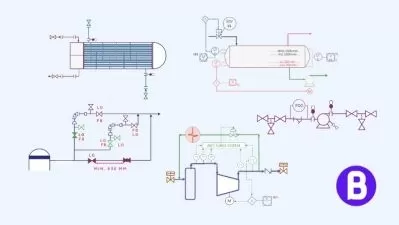Engineering Mechanics: Dynamics
Baskar P
3:43:12
Description
A Foundation Course to become an expert in Engineering Mechanics-with Regular Updates
What You'll Learn?
- The linear and angular motions of rigid bodies.
- The motion of projectiles.
- The linear and angular momentum of rigid bodies.
- The work, energy, and power.
Who is this for?
What You Need to Know?
More details
Description
What is Dynamics in Engineering Mechanics?
Dynamics is a branch of Engineering Mechanics that deals with the motion of objects. If the motion of objects is analyzed without considering the forces, then the study is called kinematics, and if the forces are considered, then it is called kinetics.
How will this course help me in my studies and career?
Engineering Mechanics is one of the core subjects in the field of engineering and technology. This subject improves your analytical skills and thinking power. That is why Engineering Mechanics is considered a core subject for engineering students at all universities worldwide.
This course will teach you an analysis of the motion of the objects, such as displacement, velocity, acceleration, and other parameters. At the end of the course, you will be able to draw out the important information from the descriptive real-world problems and perform mathematical modeling and calculation to obtain the solution. This is what you call a problem-solving ability. Also, you will be able to apply the concepts in other areas of engineering applications. In other words, you will be able to utilize the skills and knowledge gained from this course in advanced-level subjects like Strength of Materials, Machine Design, Design of Structures, and so on. Even after the successful completion of your Engineering Degree, this subject will be the base for your day-to-day engineering activities.
What will you learn from this course?
In this course, you will learn
Basic Concepts of Dynamics in Engineering Mechanics
Kinematics of Rigid Bodies
Kinetics of Rigid Bodies
Impulse and Momentum
Work, Power, energy, and more...
What is the benefit of taking this course?
My major objective is to teach you the concepts so that you will be able to easily understand them and have enough confidence to solve any problem related to Mechanics. So, I put myself in your shoes and carefully designed and presented this course. I am sure that you will be able to grasp the concepts in less time compared to other courses. I always strive to improve the quality of the course by getting feedback from students like you.
This course will help you understand various subjects like Fluid Mechanics, Dynamics of Machinery, Aircraft Structures, Structural Analysis, and so on.
How to gain maximum benefit from the course?
My best suggestion is to ...
sit in a calm and quiet place with a notebook, pen, and scientific calculator and start learning the modules according to your convenience.
note down the important points and solve the numerical examples parallel to the lectures.
complete the quizzes and assignments/exercises provided in the course.
try to answer your university/institute questions related to the concepts you learned here to get confidence.
Should I require any books for the course?
No. You don't need any books. The course has been designed by referring to the following books (Author names are in alphabetical order), and you may also refer to these books:
Vector Mechanics for Engineers – Beer and Johnston
Engineering Mechanics: Dynamics – Hibbeler
Engineering Mechanics – Meriam and Kraige
What support will you get?
You will get answers to your questions, doubts, and clarifications within 24 hours of submitting your queries, additional resources within 48 hours, and regular updates.
Please watch the Free Preview videos, and if you like the approach, you can ENROLL and start learning.
I hope to see you on the course.
Thank You!
Who this course is for:
- Science and Engineering students at diploma, graduate and post-graduate levels.
- Working professionals who are curious and wish to refresh their knowledge for advanced courses.
What is Dynamics in Engineering Mechanics?
Dynamics is a branch of Engineering Mechanics that deals with the motion of objects. If the motion of objects is analyzed without considering the forces, then the study is called kinematics, and if the forces are considered, then it is called kinetics.
How will this course help me in my studies and career?
Engineering Mechanics is one of the core subjects in the field of engineering and technology. This subject improves your analytical skills and thinking power. That is why Engineering Mechanics is considered a core subject for engineering students at all universities worldwide.
This course will teach you an analysis of the motion of the objects, such as displacement, velocity, acceleration, and other parameters. At the end of the course, you will be able to draw out the important information from the descriptive real-world problems and perform mathematical modeling and calculation to obtain the solution. This is what you call a problem-solving ability. Also, you will be able to apply the concepts in other areas of engineering applications. In other words, you will be able to utilize the skills and knowledge gained from this course in advanced-level subjects like Strength of Materials, Machine Design, Design of Structures, and so on. Even after the successful completion of your Engineering Degree, this subject will be the base for your day-to-day engineering activities.
What will you learn from this course?
In this course, you will learn
Basic Concepts of Dynamics in Engineering Mechanics
Kinematics of Rigid Bodies
Kinetics of Rigid Bodies
Impulse and Momentum
Work, Power, energy, and more...
What is the benefit of taking this course?
My major objective is to teach you the concepts so that you will be able to easily understand them and have enough confidence to solve any problem related to Mechanics. So, I put myself in your shoes and carefully designed and presented this course. I am sure that you will be able to grasp the concepts in less time compared to other courses. I always strive to improve the quality of the course by getting feedback from students like you.
This course will help you understand various subjects like Fluid Mechanics, Dynamics of Machinery, Aircraft Structures, Structural Analysis, and so on.
How to gain maximum benefit from the course?
My best suggestion is to ...
sit in a calm and quiet place with a notebook, pen, and scientific calculator and start learning the modules according to your convenience.
note down the important points and solve the numerical examples parallel to the lectures.
complete the quizzes and assignments/exercises provided in the course.
try to answer your university/institute questions related to the concepts you learned here to get confidence.
Should I require any books for the course?
No. You don't need any books. The course has been designed by referring to the following books (Author names are in alphabetical order), and you may also refer to these books:
Vector Mechanics for Engineers – Beer and Johnston
Engineering Mechanics: Dynamics – Hibbeler
Engineering Mechanics – Meriam and Kraige
What support will you get?
You will get answers to your questions, doubts, and clarifications within 24 hours of submitting your queries, additional resources within 48 hours, and regular updates.
Please watch the Free Preview videos, and if you like the approach, you can ENROLL and start learning.
I hope to see you on the course.
Thank You!
Who this course is for:
- Science and Engineering students at diploma, graduate and post-graduate levels.
- Working professionals who are curious and wish to refresh their knowledge for advanced courses.
User Reviews
Rating
Baskar P
Instructor's Courses
Udemy
View courses Udemy- language english
- Training sessions 49
- duration 3:43:12
- English subtitles has
- Release Date 2023/08/15











